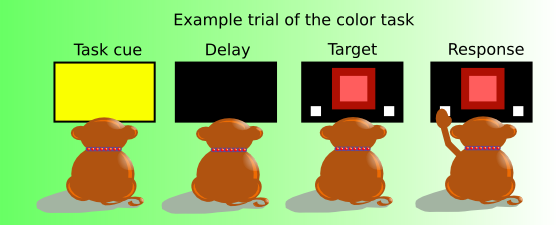
The encoding and control of tasks is an important feature of humans cognition. We developed a task-switching paradigm to study this in monkeys. Monkeys performed randomly alternating trials of two tasks. An example trial is displayed. The monkey sees a task cue (e.g., yellow screen), prepares the task, sees a target (e.g., a red square with a pattern), and responds. In this example, he presses the left button, because he was trained that the yellow screen indicates the color discrimination task, and that within that task red stimuli require a left button press. Monkeys were trained on different types of cues, task-rules, and stimuli. I recorded from 378 neurons in the posterior parietal cortex (PPC) while monkeys performed the paradigm (Neuron, 42, pp 1003-1012). In 30% of those cells (see figure on the left), I found a higher firing rate for one of the two tasks (i.e., color or brightness discrimination). This suggests that neurons in the PPC participate in task preparation. More about this project can be read on my personal web page.

